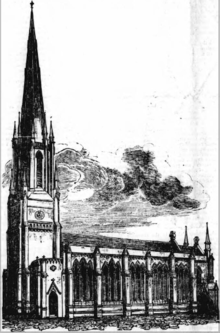Holy Trinity Church, Trinity Square
Holy Trinity Church, Nottingham was a Church of England church in Nottingham from 1841 to 1958.
| Holy Trinity Church, Nottingham | |
|---|---|
 The church as pictured in the Nottingham Review and General Advertiser for the Midland Counties Friday 15 October 1841 | |
| Country | United Kingdom |
| Denomination | Church of England |
| Churchmanship | Evangelical |
| History | |
| Dedication | Holy Trinity |
| Architecture | |
| Architect(s) | Henry Isaac Stevens |
| Style | Early English Period |
| Completed | 1841 |
| Construction cost | £10,000 |
| Demolished | 1958 |
| Specifications | |
| Capacity | 1215 |
| Length | 129 feet (39 m) |
| Width | 64 feet (20 m) |
| Spire height | 172 feet (52 m) rebuilt 2ft higher in 1861 |
| Administration | |
| Parish | Nottingham |
| Diocese | Diocese of Southwell |
| Province | York |
History
It was designed by the architect Henry Isaac Stevens.
It was a church in the early English style, dedicated to the Holy Trinity, was consecrated on 13 October 1841 by John Kaye the Bishop of Lincoln;[1] its external dimensions were 129 feet (39 m) by 64 feet (20 m), and it had a square tower, on which was an octagonal lantern 24 feet (7.3 m) high, surmounted with a spire rising 29 feet (8.8 m) feet. It was built at a cost of £10,000 (equivalent to £916,020 in 2019).[2] The living was in the gift of Trustees; and had a net income of £400.[3]
It was built on land released under the 1839 enclosure of Burton Leys[4] and out of the parish of St. Mary's Church, Nottingham.
The spire was the tallest in Nottingham. Unfortunately, the spire was declared unsafe after the heavy bombing raid in the Second World War, although there was some dispute as to whether the bombing had caused the damage,[5] and it was removed by October 1942.[6] Stones from the spire were used in the new drive at St John the Evangelist's Church, Carrington when the entrance from Mansfield Road was walled up and a new drive created from Church Drive, and other stones were incorporated into a wall on the Carrington Lido side of St John's Church.[7]
In 1859, the parishioners built Trinity Free Church as a chapel of ease to Holy Trinity. This later became independent as St. Stephen's Church, Bunker's Hill.
In 1954, Canon R.J.R. Skipper of Holy Trinity Church, Lenton, died in the pulpit whilst preaching.
Incumbents
- Thomas Francis Penrose Hart Davies 1841–1851
- Thomas Mosse MacDonald 1851–1871
- James Allan Smith 1871–1885
- William Russell Blackett 1885–1892
- Percy Holbrook 1892–1934
- Albert Tom Cosford 1934–1936
- Robert Henry Makepeace 1936–1942
- Harry Holden 1942 – ????
Organists
- W.Telford Cockrem 1871[8] - ???? (afterwards organist of St. Thomas' Church, Nottingham)
- Charles Rogers ca. 1884
- Mr. Hibbert ca. 1893
- W. Hack ca. 1910
- Vernon Sydney Read 1913 - 1920 (formerly organist of St Augustine's Church, New Basford, afterwards organist of Holy Trinity Church, Lenton)
- H. F. Dunnicliff 1925 - 1928[9] (afterwards organist of Limpsfield Parish Church, Surrey)
- H. Blyton Dobson 1928 - 1936
- Cecil Thomas Payne 1936[10] - 1940
- H. A. Gascoigne ???? - 1950
- Geoffrey Knight 1950 - ????
Closure and demolition
The church was demolished in 1958 and the Trinity Square site used for a multi-storey car park until 2006. This has now been redeveloped as the Trinity Square shopping centre.
The church name was preserved with the new Holy Trinity Church, opened in 1958 in the Nottingham suburb of Clifton.
References
- The Civil engineer and architect's journal, Volume 4. William Laxton. 1841
- UK Retail Price Index inflation figures are based on data from Clark, Gregory (2017). "The Annual RPI and Average Earnings for Britain, 1209 to Present (New Series)". MeasuringWorth. Retrieved 2 February 2020.
- A Topographical Dictionary of England (1848), pp. 446-461.
- A Centenary History of Nottingham. John Beckett. Manchester University Press. 1997
- "Holy Trinity's Spire". Nottingham Evening Post. England. 20 February 1942. Retrieved 17 September 2019 – via British Newspaper Archive.
- "Holy Trinity Spire". Nottingham Evening Post. England. 7 October 1942. Retrieved 17 September 2019 – via British Newspaper Archive.
- "Day to Day. Stones from a Demolished Spire in an appropriate place". Nottingham Evening Post. England. 12 December 1945. Retrieved 17 September 2019 – via British Newspaper Archive.
- Nottinghamshire Guardian - Friday 5 May 1871
- "Mr. H.F. Dunnicliff". Nottingham Journal. England. 13 October 1928. Retrieved 1 June 2017 – via British Newspaper Archive.
- "Holy Trinity Church Organist". Nottingham Journal. England. 14 November 1936. Retrieved 2 June 2017 – via British Newspaper Archive.
External links
- Picture the Past: archive image of interior of Holy Trinity, Nottingham
- Picture the Past: archive drawing of Holy Trinity, Nottingham
- Picture the Past: archive photo of Holy Trinity, Nottingham
- Picture the Past: archive photo of Holy Trinity, Nottingham
- Picture the Past: archive drawing of Holy Trinity, Nottingham